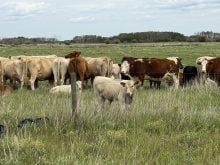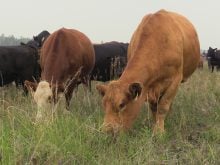This cattle market information is selected from the weekly report from Canfax, a division of the Canadian Cattlemen’s Association. More market information, analysis and statistics are available by becoming a Canfax subscriber by calling 403-275-5110 or at www.canfax.ca.
Stable fed price
Western Canadian fed prices have gone sideways for the past six weeks with prices ranging from $156-$158 per hundredweight. Western Canada has not been alone, as eastern Canadian and U.S. prices have also maintained a steady price trend.
Read Also

Canfax cattle market report – September 18, 2025
The Canfax cattle market report for September 18, 2025. Fed & feeder cattle prices, butcher cow trends, and cutout market insights.
With spot barley prices edging higher and some producers looking to free up pen space for incoming calves, it encouraged producers to market cattle. Dressed sales were reported from $263-$265 per cwt. delivered. Cattle were being scheduled for delivery the week of Nov. 1 and Nov. 8.
The Alberta fed cash-to-futures basis was reported at +$1.18 per cwt. compared to the five-year weekly average of -$2.35 per cwt. For the start of October, this is the second strongest basis in history. Only 2018 was stronger.
Over the past four weeks, western Canadian fed slaughter has averaged 45,662 head per week compared to 45,918 head per week last year. For the weeks ending Sept. 25 and Oct. 2, the Canadian Prime and AAA percentage has been more than 72 percent, new records for both weeks.
In Ontario, dressed sales were reported from $270-$272 per cwt. delivered, with most at $270 per cwt., fully steady with the previous week. The lion’s share of the cattle traded were being booked for late October delivery. Steer carcass weights averaged 947 pounds, 12 lb. larger than last year.
In the U.S., dressed sales in Iowa and Nebraska ranged from US$192-$197 per cwt., mostly steady with the previous week. Live sales in the southern feeding states were reported at mostly $124 per cwt., steady to $2 per cwt. higher than the previous week. Live cattle futures had a solid week, gaining around 500 points since Oct. 1.
U.S. beef exports for August were up 20 percent compared to last year. From January to August, beef exports to China are up 827 percent. Year to date, total U.S. beef exports are up 20.8 percent compared to last year.
Slaughter cows lower
Moderate non-fed offerings last week saw slaughter cow prices ease seasonally lower than the previous week while butcher bull prices firmed modestly higher. D2 cows dipped by $2.23 per cwt. from the previous week to average $79.17 per cwt., and D3 cows were $1.71 per cwt. lower at $69.43.
Dressed cow bids lacked momentum last week, ranging from $155-$160 per cwt. delivered. Butcher bull prices firmed $1.05 per cwt. higher to average $106.20.
Continued good export demand and moderate offerings will be supportive this week. However, trim and grind values typically bottom in October.
Feeder prices soften
Alberta feeder prices softened last week on increased offerings and somewhat limited buying interest. Calf volumes trended seasonally larger last week while yearling volumes continued to seasonally tighten.
Feeder prices eased lower as the week progressed, and no significant premiums or discounts were seen for deferred November delivery. Light calves less than 500 lb. traded unevenly compared to the previous week with steers $1.50 per cwt. on either side of steady, and similar weight heifers traded more than $2.50 per cwt. lower. Steer calves from 500-800 lb. slipped $2.50-$5 per cwt. lower last week, while heifer prices were generally $1-$3 per cwt. lower.
Fed cattle continue to occupy significant pen space in Alberta feedlots and demand for bunk replacement calves was sluggish. Large feeders heavier than 800 lb. traded around $1-$2 per cwt. lower than the previous week, but good demand continued for feeders to place against the second quarter fed market.
East and west feeder heifer prices continued to be comparable last week, and Ontario steers maintained a moderate premium to Alberta. Weekly auction offerings surged 39 percent larger than the previous week to 50,014 head.
Good eastern buying interest is expected to continue, but sluggish Alberta feedlot demand is anticipated. Manageable auction offerings were anticipated this week after Thanksgiving and are expected to trend seasonally larger through October.
Cutouts seek bottom
In U.S. beef trade, cut-out values shifted seasonally lower on lacklustre demand and ample market-ready fed cattle supplies. Choice averaged US$285.30, declining by $9.50 per cwt., and Select averaged $264.44 per cwt., down by $5 per cwt. Those prices may not yet have bottomed.














